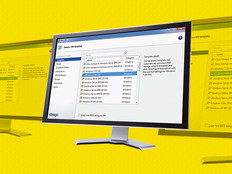How IT Helped One Firm Gain the Competitive Edge
When national professional services firm Rothstein Kass wanted to sharpen its position in a competitive market, it turned to its IT department. The technology team for the Roseland, N.J.-based firm has a long history of doing more than just keeping the servers and software running. Technology plays a value-added role in helping Rothstein Kass achieve a high level of client service.
“As we put even greater emphasis on customer service, we need to become more efficient than ever,” says IT Manager Michael De Marco. “And technology is allowing us to do that.”
Rather than just taking a near-term, tactical approach to technology upgrades, the IT group launched a multiyear plan to optimize its data center. The objective was to look closely at every core resource, from servers and storage systems to networks and operational processes.
As a result, the firm is well on its way to achieving pervasive virtualization — not only in servers but also throughout the data center. The strategy has also allowed Rothstein Kass to boost process automation and expand information sharing among staff members nationwide.
“We dove into enterprise virtualization in 2007, and at that time it was to consolidate,” De Marco says. “We saw many benefits, including cost savings for power and cooling. But as the technology evolved and the automation piece came into play, we saw new opportunities for optimization.”
The Big Picture
Rothstein Kass has been using Cisco System’s Unified Computing System to manage its virtualized resources since late 2011. The benefits are clear, starting with reductions in operating expenses. Rothstein Kass has experienced a significant reduction in the time that data center staff must devote to managing and provisioning IT resources.
The reason: The firm now relies on a central management console made possible with Cisco UCS. Together with virtualization’s ability to enable dynamic provisioning of all resources, UCS helps the IT staff quickly reallocate computing power or bring new capacity online to meet changing demands.
“This means less time is needed to devote to routine tasks,” De Marco says. This gives his department more time for strategic initiatives. He expects this heightened level of agility will have ripple effects throughout the firm by helping Rothstein Kass to quickly accommodate future growth and deliver new services as needs evolve.
“Cisco UCS is a solution that many virtualized infrastructures should consider,” adds Greg Dubiel, CDW account manager. “UCS delivers a scalable server environment that helps organizations achieve more with less.”
Central Control
Rothstein Kass uses the Cisco UCS platform to manage its virtualized resources. The platform includes UCS Manager, a central tool for controlling system configurations. Cisco UCS Manager allows storage, networking and server teams to collaborate on defining service profiles for applications.
Other features include:
- Automatic adjustments to supported servers to adjust performance according to the current needs of applications;
- Just-in-time provisioning with service profiles for storage networking, security, power and cooling, and hardware maintenance;
- Unified fabric technology to reduce cost by eliminating the need for multiple sets of adapters, cables and switches for LANs, SANs and high-performance computing networks;
- Cisco VN-Link technology for central configuration and management controls for networks connected to physical servers or virtual machines.
The Rothstein Kass IT team is seeing a significant payoff from these management capabilities. “As you try to manage different products in the data center, it can grow into a major challenge,” De Marco says. “Any way we can automate a task is a huge benefit, because you don’t need someone to manually sit there and do these jobs. And hands-off automation also means we see a reduction in manual-input errors.”
For example, if the enterprise needs a new server, the IT team uses UCS to provision a virtual machine — there’s no need to worry about related components, such as which physical computer, storage system or network connection to use.
“We are also in a refresh cycle for some of our computing resources,” De Marco notes. “So we will be phasing that in by using UCS to do the orchestration and automation piece of that project. Going forward, I will be able to just pop out a blade server and pop a new one in. I won’t have to change much in the infrastructure. We can move resources around and repurpose them,” he adds.
De Marco says his group deployed UCS in less than a week with the help of technical consultants from CDW. “They are our technology adviser, and we lean on them for guidance,” he says.
“Rothstein Kass originally turned to us to provide technical guidance around data center optimization,” adds CDW’s Dubiel. “I’m happy to say we were there from proof of concept, to delivery, to final integration.”
For the future, De Marco plans to build on current data center initiatives, using UCS to spread virtualization even further into IT operations at Rothstein Kass. “Our goal is to have every layer virtualized,” he says. And that will mean continued high levels of service for all the entirely nonvirtual customers.







